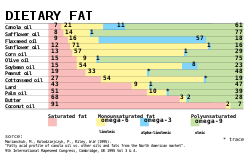Chemistry:Omega-6 fatty acid
| Types of fat]]s in food |
|---|
| See also |
Omega-6 fatty acids (also referred to as ω-6 fatty acids or n-6 fatty acids) are a family of polyunsaturated fatty acids that have in common a final carbon-carbon double bond in the n-6 position, that is, the sixth bond, counting from the methyl end.[1]
Health effects
The American Heart Association "supports an omega-6 PUFA intake of at least 5% to 10% of energy in the context of other AHA lifestyle and dietary recommendations. To reduce omega-6 PUFA intakes from their current levels would be more likely to increase than to decrease risk for CHD."[2]
A 2018 review found that an increased intake of omega‐6 fatty acids has been shown to reduce total serum cholesterol and may reduce myocardial infarction (heart attack), but found no significant change in LDL cholesterol and triglycerides.[3] A 2021 review found that omega-6 supplements do not affect the risk of CVD morbidity and mortality.[4]
A 2023 review found that omega-6 polyunsaturated fatty acids are associated with lower risk of high blood pressure.[5] Omega‐6 fatty acids are not associated with atrial fibrillation.[6]
Dietary sources
Dietary sources of omega-6 fatty acids include:[7]
- poultry
- eggs
- nuts
- hulled sesame seeds
- cereals
- durum wheat
- whole-grain breads
- pumpkin seeds
- hemp seeds
Vegetable oils
Vegetable oils are a major source of omega-6 linoleic acid. Worldwide, more than 100 million metric tons of vegetable oils are extracted annually from palm fruits, soybean seeds, rape seeds, and sunflower seeds, providing more than 32 million metric tons of omega-6 linoleic acid and 4 million metric tons of omega-3 alpha-linolenic acid.[8][9]
List of omega-6 fatty acids

| Common name | Lipid name | Chemical name |
|---|---|---|
| Linoleic acid (LA) | 18:2 (n−6) | all-cis-9,12-octadecadienoic acid |
| Gamma-linolenic acid (GLA) | 18:3 (n−6) | all-cis-6,9,12-octadecatrienoic acid |
| Calendic acid | 18:3 (n−6) | 8E,10E,12Z-octadecatrienoic acid |
| Eicosadienoic acid | 20:2 (n−6) | all-cis-11,14-eicosadienoic acid |
| Dihomo-gamma-linolenic acid (DGLA) | 20:3 (n−6) | all-cis-8,11,14-eicosatrienoic acid |
| Arachidonic acid (AA, ARA) | 20:4 (n−6) | all-cis-5,8,11,14-eicosatetraenoic acid |
| Docosadienoic acid | 22:2 (n−6) | all-cis-13,16-docosadienoic acid |
| Adrenic acid | 22:4 (n−6) | all-cis-7,10,13,16-docosatetraenoic acid |
| Osbond acid | 22:5 (n−6) | all-cis-4,7,10,13,16-docosapentaenoic acid |
| Tetracosatetraenoic acid | 24:4 (n−6) | all-cis-9,12,15,18-tetracosatetraenoic acid |
| Tetracosapentaenoic acid | 24:5 (n−6) | all-cis-6,9,12,15,18-tetracosapentaenoic acid |
The melting point of the fatty acids increases as the number of carbons in the chain increases.[10]
See also
- Cattle feeding
- Essential fatty acid interactions
- Essential nutrients
- Inflammation
- Linolenic acid
- Lipid peroxidation
- Olive oil regulation and adulteration
- Omega-3 fatty acid
- Omega-7 fatty acid
- Omega-9 fatty acid
- Ratio of fatty acids in different foods
- Wheat germ oil
References
- ↑ Chow, Ching Kuang (2001). Fatty Acids in Foods and Their Health Implications. New York: Routledge Publishing. OCLC 25508943.[page needed]
- ↑ Harris, WS; Mozaffarian, D; Rimm, E; Kris-Etherton, P; Rudel, LL; Appel, LJ; Engler, MM; Engler, MB et al. (2009). "Omega-6 fatty acids and risk for cardiovascular disease: a science advisory from the American Heart Association Nutrition Subcommittee of the Council on Nutrition, Physical Activity, and Metabolism; Council on Cardiovascular Nursing; and Council on Epidemiology and Prevention". Circulation 119 (6): 902–7. doi:10.1161/CIRCULATIONAHA.108.191627. PMID 19171857.
- ↑ "Omega‐6 fats for the primary and secondary prevention of cardiovascular disease". Cochrane Database of Systematic Reviews 11: CD011094. 2018. doi:10.1002/14651858.CD011094.pub4. PMID 30488422.
- ↑ "Omega-6 fatty acids and the risk of cardiovascular disease: insights from a systematic review and meta-analysis of randomized controlled trials and a Mendelian randomization study". Archives of Medical Science 18 (2): 466–479. 2021. doi:10.5114/aoms/136070. PMID 35316920.
- ↑ Hajihashemi P, Feizi A, Heidari Z, Haghighatdoost F. (2023). "Association of omega-6 polyunsaturated fatty acids with blood pressure: A systematic review and meta-analysis of observational studies". Critical Reviews in Food Science and Nutrition 63 (14): 2247–2259. doi:10.1080/10408398.2021.1973364. PMID 36939291. https://www.tandfonline.com/doi/abs/10.1080/10408398.2021.1973364.
- ↑ Garg PK, Guan W, Nomura S, Weir NL, Tintle N, Virtanen JK, Hirakawa Y, Qian F, Sun Q, Rimm E, Lemaitre RN, Jensen PN, Heckbert SR, Imamura F, Steur M, Leander K, Laguzzi F, Voortman T, Ninomiya T, Mozaffarian D, Harris WS, Siscovick DS, Tsai MY (2023). "Fatty Acids and Outcomes Research Consortium (FORCE). n-6 fatty acid biomarkers and incident atrial fibrillation: an individual participant-level pooled analysis of 11 international prospective studies.". The American Journal of Clinical Nutrition 118 (5): 921-929. doi:10.1016/j.ajcnut.2023.09.008. PMID 37769813.
- ↑ "Food sources of total omega 6 fatty acids". http://riskfactor.cancer.gov/diet/foodsources/fatty_acids/table2.html.
- ↑ Gunstone, Frank (December 2007). "Market update: Palm oil". International News on Fats, Oils and Related Materials 18 (12): 835–36. http://www.highbeam.com/doc/1P3-1421893231.html.
- ↑ "Soybean Oil Prices Suddenly Diverge from Energy Market". Oilseeds: World Market and Trade (USDA) (January 2009). 2009-01-12. FOP 1-09. http://www.fas.usda.gov/oilseeds/circular/2009/January/Oilseedsfull0109.pdf. Retrieved 2019-08-09., Table 03: Major Vegetable Oils: World Supply and Distribution at Oilseeds: World Markets and Trade Monthly Circular
- ↑ "Biochemical Properties of Lipids" (in en-US). 2020-04-30. https://themedicalbiochemistrypage.org/biochemistry-of-lipids/.
Bibliography
- Tokar, Steve (2005-09-02). "Omega-6 fatty acids cause prostate tumor cell growth in culture". Medical News Today (MediLexicon International). http://www.medicalnewstoday.com/articles/29976.php.
- "Brain fatty acid levels linked to depression". News-Medical.Net (AZoNetwork). 2005-05-25. http://www.news-medical.net/?id=10398.
- Tribole, E.F. (2006-03-27). "Excess Omega-6 Fats Thwart Health Benefits from Omega-3 Fats". British Medical Journal Rapid Responses to Hooper, et Al., 2006 332 (7544): 752. http://www.bmj.com/rapid-response/2011/10/31/excess-omega-6-fats-thwart-health-benefits-omega-3-fats. Retrieved 2008-03-23.
- Erasmus, Udo (1993). Fats That Heal, Fats That Kill (3rd ed.). Burnaby (BC): Alive Books. ISBN 978-0-920470-38-1.
de:Omega-n-Fettsäuren#Omega-6-Fettsäuren
 |



